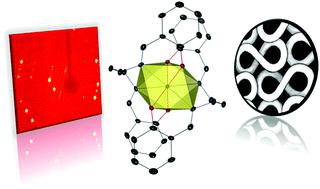当前位置:
X-MOL 学术
›
Dalton Trans.
›
论文详情
Our official English website, www.x-mol.net, welcomes your feedback! (Note: you will need to create a separate account there.)
Systematic comparison of the structure of homoleptic tetradentate N2O2-type Schiff base complexes of tetravalent f-elements (M(IV) = Ce, Th, U, Np, and Pu) in solid state and in solution
Dalton Transactions ( IF 4 ) Pub Date : 2020-11-20 , DOI: 10.1039/d0dt03405c Thomas Radoske 1, 2, 3, 4 , Roger Kloditz 1, 2, 3, 4 , Sebastian Fichter 1, 2, 3, 4 , Juliane März 1, 2, 3, 4 , Peter Kaden 1, 2, 3, 4 , Michael Patzschke 1, 2, 3, 4 , Moritz Schmidt 1, 2, 3, 4 , Thorsten Stumpf 1, 2, 3, 4 , Olaf Walter 4, 5, 6, 7 , Atsushi Ikeda-Ohno 1, 2, 3, 4, 8
Dalton Transactions ( IF 4 ) Pub Date : 2020-11-20 , DOI: 10.1039/d0dt03405c Thomas Radoske 1, 2, 3, 4 , Roger Kloditz 1, 2, 3, 4 , Sebastian Fichter 1, 2, 3, 4 , Juliane März 1, 2, 3, 4 , Peter Kaden 1, 2, 3, 4 , Michael Patzschke 1, 2, 3, 4 , Moritz Schmidt 1, 2, 3, 4 , Thorsten Stumpf 1, 2, 3, 4 , Olaf Walter 4, 5, 6, 7 , Atsushi Ikeda-Ohno 1, 2, 3, 4, 8
Affiliation

|
A series of tetradentate N2O2-type Schiff base complexes with tetravalent 4f- and 5f-block metals, [M(salpn)2] (H2salpn = N,N′-disalicylidene-1,3-diaminopropane; M = Ce, Th, U, Np, and Pu), were prepared to systematically investigate their solid state structure, and their complexation behaviour in solution with the goal to investigate the subtle differences between 4f- and 5f-elements. X-ray diffraction revealed that all investigated metal cations form [M(salpn)2] complexes. All the complexes show the same ligand arrangement with meridional conformation, amongst which only Ce(IV) exhibits unique behaviour upon crystallisation. [Ce(salpn)2] crystallises in two less symmetric systems (P![[1 with combining macron]](https://www.rsc.org/images/entities/char_0031_0304.gif) or P21/n), whilst all the other [M(salpn)2] crystallise in a more symmetric orthorhombic system (Pban). Quantum chemical calculations suggest that the observed structural peculiarity of Ce(IV) stems from the geometrical flexibility due to the more “ionic” nature of bonds to the 4f element. 1H NMR measurements revealed that [M(salpn)2] forms two different species in solution with and without an additional solvent molecule, where the relative distribution of the two species depends mainly on the ionic radius of the metal centre. Again, Ce(IV) behaves differently from the tetravalent actinides with a higher ratio of the solvent-molecule-coordinated species than the ratio expected from its ionic radius. Hence, this study is successful in observing subtle differences between 4f- (i.e. Ce) and 5f-elements (actinides; Th, U, Np, and Pu) both in the solid state and in solution on an analytically distinguishable level, and in relating the observed subtle differences to their electronic structure.
or P21/n), whilst all the other [M(salpn)2] crystallise in a more symmetric orthorhombic system (Pban). Quantum chemical calculations suggest that the observed structural peculiarity of Ce(IV) stems from the geometrical flexibility due to the more “ionic” nature of bonds to the 4f element. 1H NMR measurements revealed that [M(salpn)2] forms two different species in solution with and without an additional solvent molecule, where the relative distribution of the two species depends mainly on the ionic radius of the metal centre. Again, Ce(IV) behaves differently from the tetravalent actinides with a higher ratio of the solvent-molecule-coordinated species than the ratio expected from its ionic radius. Hence, this study is successful in observing subtle differences between 4f- (i.e. Ce) and 5f-elements (actinides; Th, U, Np, and Pu) both in the solid state and in solution on an analytically distinguishable level, and in relating the observed subtle differences to their electronic structure.
中文翻译:

系统比较四价f元素(M(IV)= Ce,Th,U,Np和Pu)的均质四齿N2O2型Schiff碱配合物的固态和溶液结构
一系列具有四价4f和5f嵌段金属[M(salpn)2 ]的四齿N 2 O 2型席夫碱配合物(H 2 salpn = N,N'-二水杨基-1,3-二氨基丙烷; M = Ce,Th,U,Np和Pu)的制备旨在系统地研究它们的固态结构以及它们在溶液中的络合行为,目的是研究4f和5f元素之间的细微差异。X射线衍射表明,所有研究的金属阳离子形成[M(salpn)2 ]配合物。所有的配合物都显示出相同的配体排列和子午构象,其中只有Ce(IV)在结晶时表现出独特的行为。[Ce(salpn)2 ]在两个不太对称的系统中结晶(P![[1个结合宏]](https://www.rsc.org/images/entities/char_0031_0304.gif) 或P 2 1 / n),而所有其他[M(salpn)2 ]在一个更对称的正交晶体系统(Pban)中结晶。量子化学计算表明,所观察到的Ce(IV)的结构特殊性是由于其与4f元素的键具有更“离子”性质,因此其几何形状具有弹性。1 H NMR测量表明[M(salpn)2]在溶液中有或没有其他溶剂分子时会形成两种不同的物质,其中两种物质的相对分布主要取决于金属中心的离子半径。同样,Ce(IV)的行为与四价valent系元素不同,溶剂-分子配位物种的比例高于其离子半径所预期的比例。因此,这项研究成功地观察到了固态和溶液中4f-(即Ce)和5f元素(act系元素; ,、 U,Np和Pu)之间的细微差异,并且在分析上可区分。观察到的对其电子结构的细微差异。
或P 2 1 / n),而所有其他[M(salpn)2 ]在一个更对称的正交晶体系统(Pban)中结晶。量子化学计算表明,所观察到的Ce(IV)的结构特殊性是由于其与4f元素的键具有更“离子”性质,因此其几何形状具有弹性。1 H NMR测量表明[M(salpn)2]在溶液中有或没有其他溶剂分子时会形成两种不同的物质,其中两种物质的相对分布主要取决于金属中心的离子半径。同样,Ce(IV)的行为与四价valent系元素不同,溶剂-分子配位物种的比例高于其离子半径所预期的比例。因此,这项研究成功地观察到了固态和溶液中4f-(即Ce)和5f元素(act系元素; ,、 U,Np和Pu)之间的细微差异,并且在分析上可区分。观察到的对其电子结构的细微差异。
更新日期:2020-11-21
![[1 with combining macron]](https://www.rsc.org/images/entities/char_0031_0304.gif) or P21/n), whilst all the other [M(salpn)2] crystallise in a more symmetric orthorhombic system (Pban). Quantum chemical calculations suggest that the observed structural peculiarity of Ce(IV) stems from the geometrical flexibility due to the more “ionic” nature of bonds to the 4f element. 1H NMR measurements revealed that [M(salpn)2] forms two different species in solution with and without an additional solvent molecule, where the relative distribution of the two species depends mainly on the ionic radius of the metal centre. Again, Ce(IV) behaves differently from the tetravalent actinides with a higher ratio of the solvent-molecule-coordinated species than the ratio expected from its ionic radius. Hence, this study is successful in observing subtle differences between 4f- (i.e. Ce) and 5f-elements (actinides; Th, U, Np, and Pu) both in the solid state and in solution on an analytically distinguishable level, and in relating the observed subtle differences to their electronic structure.
or P21/n), whilst all the other [M(salpn)2] crystallise in a more symmetric orthorhombic system (Pban). Quantum chemical calculations suggest that the observed structural peculiarity of Ce(IV) stems from the geometrical flexibility due to the more “ionic” nature of bonds to the 4f element. 1H NMR measurements revealed that [M(salpn)2] forms two different species in solution with and without an additional solvent molecule, where the relative distribution of the two species depends mainly on the ionic radius of the metal centre. Again, Ce(IV) behaves differently from the tetravalent actinides with a higher ratio of the solvent-molecule-coordinated species than the ratio expected from its ionic radius. Hence, this study is successful in observing subtle differences between 4f- (i.e. Ce) and 5f-elements (actinides; Th, U, Np, and Pu) both in the solid state and in solution on an analytically distinguishable level, and in relating the observed subtle differences to their electronic structure.
中文翻译:

系统比较四价f元素(M(IV)= Ce,Th,U,Np和Pu)的均质四齿N2O2型Schiff碱配合物的固态和溶液结构
一系列具有四价4f和5f嵌段金属[M(salpn)2 ]的四齿N 2 O 2型席夫碱配合物(H 2 salpn = N,N'-二水杨基-1,3-二氨基丙烷; M = Ce,Th,U,Np和Pu)的制备旨在系统地研究它们的固态结构以及它们在溶液中的络合行为,目的是研究4f和5f元素之间的细微差异。X射线衍射表明,所有研究的金属阳离子形成[M(salpn)2 ]配合物。所有的配合物都显示出相同的配体排列和子午构象,其中只有Ce(IV)在结晶时表现出独特的行为。[Ce(salpn)2 ]在两个不太对称的系统中结晶(P
![[1个结合宏]](https://www.rsc.org/images/entities/char_0031_0304.gif) 或P 2 1 / n),而所有其他[M(salpn)2 ]在一个更对称的正交晶体系统(Pban)中结晶。量子化学计算表明,所观察到的Ce(IV)的结构特殊性是由于其与4f元素的键具有更“离子”性质,因此其几何形状具有弹性。1 H NMR测量表明[M(salpn)2]在溶液中有或没有其他溶剂分子时会形成两种不同的物质,其中两种物质的相对分布主要取决于金属中心的离子半径。同样,Ce(IV)的行为与四价valent系元素不同,溶剂-分子配位物种的比例高于其离子半径所预期的比例。因此,这项研究成功地观察到了固态和溶液中4f-(即Ce)和5f元素(act系元素; ,、 U,Np和Pu)之间的细微差异,并且在分析上可区分。观察到的对其电子结构的细微差异。
或P 2 1 / n),而所有其他[M(salpn)2 ]在一个更对称的正交晶体系统(Pban)中结晶。量子化学计算表明,所观察到的Ce(IV)的结构特殊性是由于其与4f元素的键具有更“离子”性质,因此其几何形状具有弹性。1 H NMR测量表明[M(salpn)2]在溶液中有或没有其他溶剂分子时会形成两种不同的物质,其中两种物质的相对分布主要取决于金属中心的离子半径。同样,Ce(IV)的行为与四价valent系元素不同,溶剂-分子配位物种的比例高于其离子半径所预期的比例。因此,这项研究成功地观察到了固态和溶液中4f-(即Ce)和5f元素(act系元素; ,、 U,Np和Pu)之间的细微差异,并且在分析上可区分。观察到的对其电子结构的细微差异。


























 京公网安备 11010802027423号
京公网安备 11010802027423号